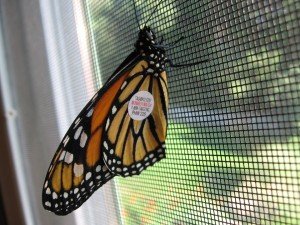Bringing Up Baby (Monarchs)
My friend Tammi rears Monarchs. Her hobby of collecting the eggs, caring for the caterpillars, and releasing Monarch butterflies has grown to the point that this summer she tagged and released 178 of them! So in early August, when I found a tiny Monarch caterpillar on a milkweed plant in my garden, I knew what to do. I’ve always wanted to closely observe the process of a Monarch caterpillar transforming into a butterfly, so I plucked the leaf and brought the wee black, white, and yellow striped thing into the house.
I set it, with its leaf, on a plate covered with a paper towel. Over the top I placed a dome-shaped screen: you know, the kind that protects picnic food from insects. Perfect!
Over the next couple weeks, I carefully replaced chewed leaves with fresh new ones, and my little tiny caterpillar grew and grew. It crawled to the apex of the dome and rested periodically, giving itself time to molt, and then continued its dedicated munching. I was fascinated. This thing could really eat! I couldn’t wait to wake up and see how big it had gotten overnight.
One day I came home from a day of kayaking to find a beautiful, luminescent green chrysalis attached to the top of the dome. The deed was done, and I was sorry to have missed the process (I guess I would have been more sorry if I’d been home and missed it!) Now though, we had entered the next phase. I had just 9-12 days to wait for it to emerge, transformed. I didn’t snap a photo of this phase, but here is an awe-inspiring photo from Tammi’s Monarch nursery. It includes a caterpillar adhered to the top of the enclosure in its J shape, just before it forms a chrysalis.
I waited a little over 2 weeks and began to worry, but Tammi told me chilly conditions can delay the butterfly’s emergence, so I sat tight. This time, I was in the right place at the right time. It happened silently, so I’m not sure what drew my eye in that direction. I had moved the dome up where my cats couldn’t reach it, in case I wasn’t home when the butterfly made its debut. At the moment I looked over, the butterfly was slowly but nimbly escaping from its encasement. I held my breath and peered through the screen, then gently lifted the dome and snapped this photo.
The next morning I debated whether to release the butterfly; it wasn’t quite 60 degrees, and was slightly overcast. I knew my orange and black beauty had gotten strong overnight. Now it opened and closed its wings as if readying itself for flight. I took the screen dome outside to my Mexican Sunflower plant in the garden and helped the Monarch onto one of the flowers. Its colors were stunning: so bright and clean. It rested there, and I wished it well, said goodbye, and left for work. When I came back, it was gone, presumably on its way to Mexico. Adios mi amigo!
Why do people raise Monarchs? Tammi told me that Monarch habitat is shrinking due to development. Fewer prairies and wild areas mean less milkweed, their exclusive source of food in the caterpillar stage. Also, the caterpillars are subject to predation, and only a very low percentage make it to the butterfly stage in the wild. Tammi had about 98% “fledged” Monarchs, which is a typical success rate for the caring people engaged in this worthwhile endeavor. Go to monarchwatch.org to learn more. Oh, and if you want a great binocular for butterfly watching, choose the Pentax Papillio, the only binocular I know of with an incredible 18″ close focus! Call us at Eagle Optics to find out more.
Originally published on October 13, 2011
